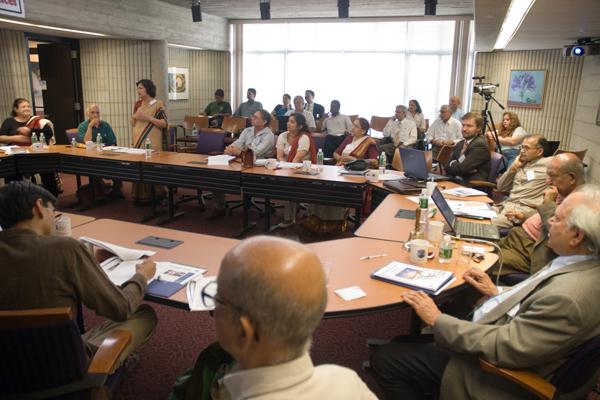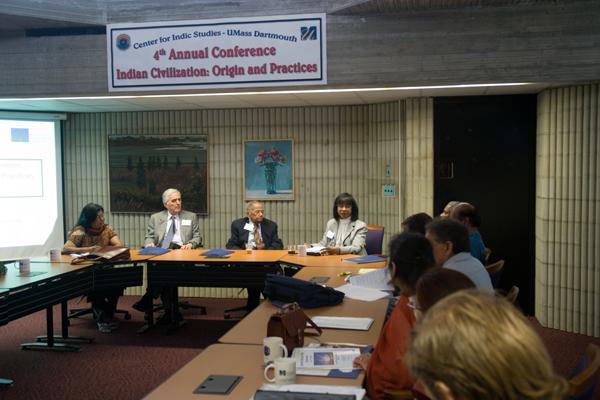Contribute
| Indian Joint Family System Cited As The Cradle Of Future World |
Press Release
01/18/2007
A gathering of over a dozen scholars from India and United States recently took a comprehensive stock of the social and family conditions in the world, and developed a consensus that an all encompassing development and peace in society is only possible with the time-tested value system of joint family.
While decrying the custom of paying dowry and the ever increasing greed of society, Dr. Divya Tripathi of DAV College of Girls, Haryana, India, speaking on the Vedic Philosophy of Marriage propounded that “the entire thrust of Vedic philosophy is to attain worldly happiness and spiritual upliftment as the goal of life.â€
Citing Vedas, Dr. Tripathi, outlined the ways to achieve the goals of life is scrupulously follow the four ashramas or stages of life, of which Grihasthashrama or householder stage is given the highest status. The backbone of the Grihasthashrama is marriage, which has attracted the most elaborate descriptions from Vedas to various smiritis (memoirs of great sages and rulers) and Puranas, the ancient historical accounts of Indian traditions.
“Any relationship must bring out growth and harmony at the individual, family, and society levels, otherwise it would not workâ€, said Professor Madhu Jhaveri in his presentation on Integrating Principles of a Hindu Family System. And, the growth should involve physical or material, mental or intellectual, and spiritual. Dr. Jhaveri pointed out that marriage or husband-wife relationship should be looked at from this point of view.
Despite strong tradition of joint family system in India, major shifts in attitudes is taking place even in India, where at least in cities and towns nuclearization of families is taking place. According Professor V. T. Patil, “the joint family system which has established its resilience over a long period in Indian history may undergo a major transformation in the light of momentous systemic developments like the impact of modernization, globalization, liberalization, and science and technology.â€
The fact that breaking of the joint family in India is afoot is obvious from the number of elderly people are being placed in ‘pay and stay homes’. According to Dr. Jyotsna Kalavar of Penn State University, there is a tremendous increase in the elderly population in such institutions in India. She attributed to this change to “dual career families, changing values, and nuclear family dynamics.â€
An interesting observation made by Professor Kalavar with elderly people living in pay and stay homes in Chennai area was that they had more contacts with their daughters than sons, which “appears to be a departure from traditional expectations placed on the male child for provision of late life care.†However, a question remains whether less contact with sons is due to a negative role played by the daughter-in-law.
Speaking in support of the joint family system, Dr. Mona Khaitan, a professor of business in MassBay Community College, presented data suggesting the joint family system fares better economically. According to the National Family Health Survey of 1998-1999, while joint families form only 35% of the low income households, they form 53% of the high income households.
Dr. Khaitan explained the better economic success of the joint family as it “enjoys the economies of scale; the costs are lower than if two or three households were to be maintained, making for increased income.â€
In addition to the economic advantage, Professor Khaitan advanced the idea of ‘relational wealth’, original proposed by late Professor Romesh Diwan of Rensselaer Polytechnic College in Troy, NY. This is intangible wealth amassed that promotes physical, emotional, intellectual, and psychic wellbeing of each individual.
Writing in an article entitled “Gandhian economics – An Empirical Perspective†in 2001, Dr. Diwan had written that “it (relational wealth) is a state where people live together in families of blood relations or of friends, where commitments are made and kept, where one’s greatest pleasure is to see that the other person is satisfied and happy.â€
Dr. Rabi Mishra, an economist from Harvard University, emphasized that many of the philosophical underpinnings of Indian society “are ingrained in various customs and rituals observed by a typical family across the twelve months of a year.â€
He, however, warned that “human race is at a critical juncture now with material desires trying to reign over its mind. The march towards self destruction is on. It is time one remembers and relearns the ethics of Indian family system to set the drowning ship in order.â€
That warning may turn out to be literally true, according to Dr. Bal Ram Singh, Director, Center for Indic Studies at UMass Dartmouth. He presented data from an article published in journal Nature in 2003 that predicts that “if the joint family system in a country of India’s size is dismantled, the planet can not be sustained due to the exploitation of natural resources for housing and other social, economic, and energy needs.â€
Sociologist Dr. V. D. Misra of Lucknow University presented the history, fundamentals, and objectives of Indian family system in the context of future as the global family system or Vasudhaivakutumbakam.
Modernization and globalization while present a great challenge to maintain in the face of need and desire for mobility, separation, and individualism, there is also a greater understanding of global issues of environmental erosion and natural living. There are social challenges to maintain the essence of joint family system in modern world.
Honorable C. M. Bhandari, who is currently the Indian ambassador to United Arab Emirates, used his personal example to suggest that the idea of joint family can be practiced effectively in today’s world.
A critical point made by several of the scholars was the leadership of women in family affairs. Dr. Divya Tripathi quoted Mahabharata to say “the house is not the home, the mistress of the house is called the home.â€
According to Dr. Tripathi, the value of traditional value system and status of women got badly affected with the passage of time because of reasons like political and cultural invasions, urbanization, industrialization, changed socio-economic conditions, etc.
Problems such as dowry and female foeticide have made inroads in the Indian society. However, according to a series of data gender ratio presented by Dr. Singh India is among the top three countries to maintain the natural gender ratio in different age groups.
“There is so much misunderstanding about India’s traditions, especially their scholarly analysis, both in India and abroad.†said Dr. Singh who organized the symposium on Indian Family System as part of the Indian Civilization Conference. “We hope to systematically address these issues as part of our mission at the Center for Indic Studies.â€
The conference was sponsored by the Center for Indic Studies at UMass Dartmouth and Educators Society for the Heritage of India (ESHI).
You may also access this article through our web-site http://www.lokvani.com/

